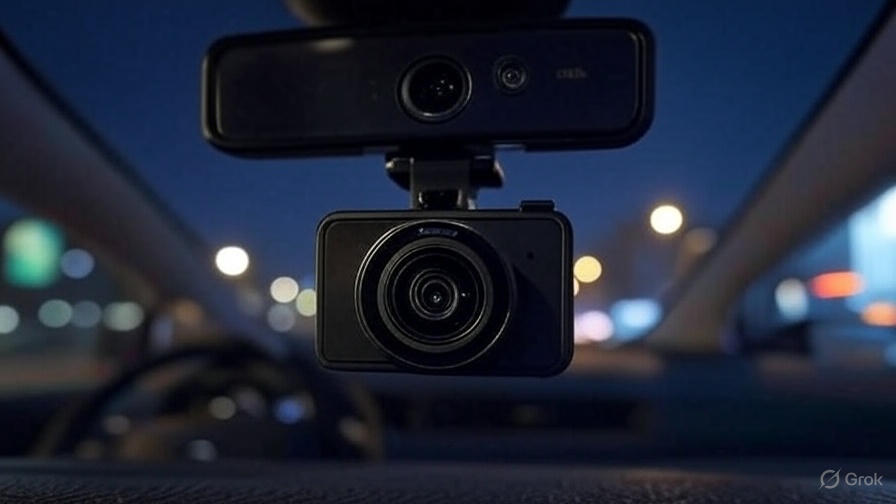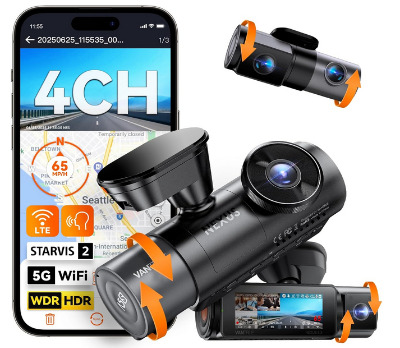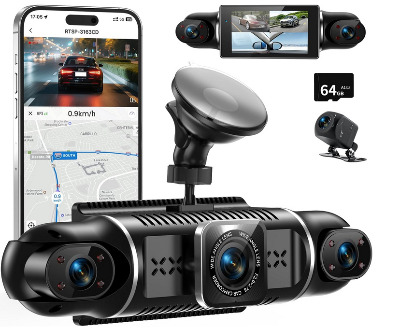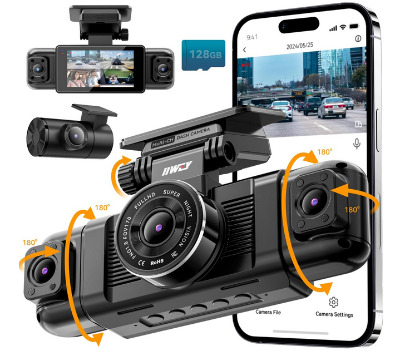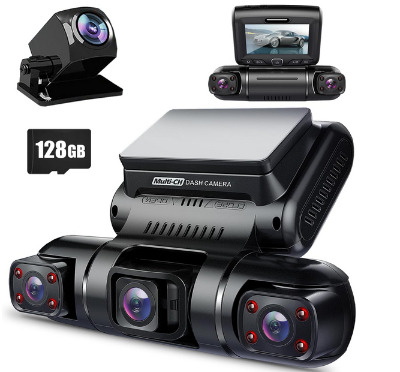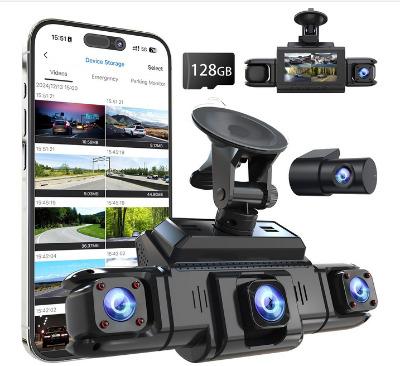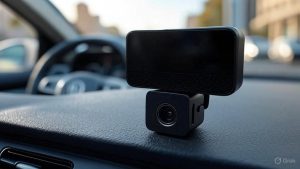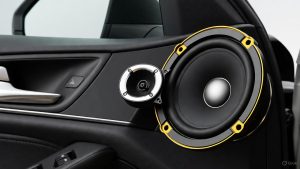Vehicle security has become a paramount concern for drivers worldwide. Traditional single-lens dash cameras provide limited coverage, leaving blind spots that could prove critical during accidents or security incidents. Four-channel 360-degree dash cameras revolutionize vehicle monitoring by offering complete coverage around your car. These sophisticated systems record simultaneously from front, rear, left, right, and interior angles, ensuring no incident goes unrecorded.
Modern 360 dash cam systems deliver comprehensive protection through advanced features like GPS tracking, WiFi connectivity, night vision capabilities, and intelligent parking mode. The technology has evolved dramatically, bringing professional-grade surveillance to everyday drivers. These systems serve multiple purposes: insurance claim support, theft prevention, driver behavior monitoring, and evidence collection for legal proceedings.
The investment in a quality 360 dash cam system pays dividends through enhanced security, potential insurance discounts, and peace of mind while driving or parking. Professional drivers, rideshare operators, and security-conscious individuals find these systems indispensable for their daily operations.
Why 360 Degree Coverage Matters
Complete vehicle surveillance eliminates dangerous blind spots that single or dual-camera systems cannot address. Side-impact collisions, hit-and-run incidents, and vandalism often occur outside the range of traditional forward-facing cameras. Four-channel systems capture every angle, providing irrefutable evidence when incidents occur.
Insurance companies increasingly recognize the value of comprehensive dash cam footage. Complete 360-degree coverage strengthens claims by providing clear evidence of fault determination, reducing disputed claims and potential premium increases. The footage serves as an impartial witness during complex multi-vehicle accidents where fault determination becomes challenging.
Fleet managers and commercial operators benefit significantly from 360-degree monitoring systems. These cameras help improve driver behavior, reduce liability exposure, and provide training opportunities based on real-world driving scenarios. The systems also protect against fraudulent injury claims and provide evidence for worker’s compensation cases.
Key Features to Consider
Video Quality and Resolution
Recording resolution directly impacts the usability of captured footage. High-definition recording ensures license plates remain readable, facial features are distinguishable, and environmental details are clearly captured. Modern systems offer various resolution combinations, with front cameras typically providing the highest quality recording.
Frame rate stability affects video smoothness and detail capture during fast-moving incidents. Higher frame rates provide better motion clarity but consume more storage space. The balance between quality and storage efficiency becomes crucial for extended recording periods.
Color reproduction accuracy helps identify vehicle colors, clothing details, and environmental conditions during incidents. Wide Dynamic Range (WDR) technology improves footage quality in challenging lighting conditions, such as tunnels, bridges, or dramatic weather changes.
Night Vision Capabilities
Low-light performance separates premium dash cam systems from basic models. Advanced sensors and infrared illumination ensure clear recording during nighttime driving or in poorly lit parking areas. Interior cameras require particularly strong night vision capabilities to monitor passenger compartments effectively.
Infrared LED arrays provide illumination without disturbing drivers or passengers. The number and positioning of IR lamps affect coverage area and illumination quality. Quality systems balance adequate lighting with energy efficiency to prevent excessive battery drain.
Automatic light adjustment ensures optimal recording quality as lighting conditions change throughout the day. Smart sensors detect ambient light levels and adjust camera settings accordingly, maintaining consistent footage quality without manual intervention.
Storage and Recording Options
Loop recording functionality ensures continuous operation by automatically overwriting older footage when storage reaches capacity. Emergency file protection prevents critical footage from being overwritten during routine operation. G-sensor technology automatically locks important files during sudden impacts or aggressive driving maneuvers.
Storage capacity requirements vary based on recording quality, number of channels, and retention preferences. High-capacity memory cards enable longer retention periods but increase system costs. Cloud storage options provide off-site backup but require ongoing subscription fees.
Parking mode recording extends protection while the vehicle remains unattended. Motion detection and impact sensors trigger recording when suspicious activity occurs around the parked vehicle. Time-lapse recording reduces storage consumption while maintaining security coverage.
Connectivity and Smart Features
WiFi connectivity enables smartphone app control, footage review, and settings adjustment without removing memory cards. Remote access capabilities allow fleet managers or family members to monitor vehicle status and review incidents in real-time.
GPS integration provides location tracking, speed monitoring, and route recording capabilities. This information becomes valuable during insurance claims and legal proceedings, providing context for recorded incidents. Speed alerts help drivers maintain safe driving practices and avoid traffic violations.
Voice control features allow hands-free operation while driving, improving safety by reducing driver distraction. Emergency recording activation, system status checks, and basic controls can be managed through voice commands.
Top 5 Best 360 Dash Cams Reviewed
1. Vantrue N5S 4 Channel 360 Degree WiFi Dash Cam
The Vantrue N5S represents the pinnacle of dash cam technology, combining cutting-edge STARVIS 2 sensor technology with comprehensive four-channel recording. This premium system delivers exceptional 2.7K front recording resolution paired with multiple 1080P and 1440P cameras for complete vehicle coverage.
Technical Specifications:
- Front Camera: 2.7K resolution with STARVIS 2 sensor
- Interior Camera: 1440P with advanced night vision
- Side Cameras: Dual 1080P recording
- Storage: Supports up to 1TB memory cards
- Connectivity: WiFi, GPS, LTE support capability
- Power: 24-hour parking mode with hardwire kit
The STARVIS 2 sensor technology provides superior low-light performance, capturing clear footage even in challenging nighttime conditions. The IR night vision system illuminates the vehicle interior without disturbing occupants, making it ideal for rideshare drivers and families concerned about passenger safety.
Voice control functionality allows drivers to activate emergency recording, check system status, or adjust basic settings without taking hands off the wheel. The intuitive voice commands respond accurately even in noisy driving environments.
GPS integration tracks vehicle location, speed, and route information, embedding this data directly into recorded footage. This feature proves invaluable during insurance claims and legal proceedings, providing irrefutable evidence of driving conditions and vehicle behavior.
The 24-hour parking mode offers three distinct monitoring levels: motion detection, impact detection, and time-lapse recording. Smart power management prevents battery drain while maintaining security coverage. The system automatically switches between driving and parking modes based on vehicle operation.
LTE support capability (requires separate data plan) enables real-time monitoring and remote access to recorded footage. Fleet managers can track vehicle locations, review driving behavior, and respond quickly to incidents or emergencies.
Pros:
- Exceptional night vision performance
- Professional-grade build quality
- Comprehensive app control
- Advanced parking mode options
- High storage capacity support
Cons:
- Premium price point
- Complex installation requirements
- Large memory card investment needed
2. 4 Channel Car Dash Cam 360° Coverage
This value-oriented system provides complete 360-degree coverage without compromising essential features. The front 2K camera delivers sharp footage while triple 1080P cameras cover rear, interior, and side angles comprehensively.
Technical Specifications:
- Front Camera: 2K recording resolution
- Additional Cameras: Triple 1080P coverage
- Storage: Included 64GB SD card
- Connectivity: Built-in WiFi with smartphone app
- Features: G-sensor, night vision, parking mode
- Recording: Loop recording with emergency protection
The built-in WiFi system connects seamlessly with dedicated smartphone applications, allowing real-time footage review and system configuration. Users can download important clips directly to their phones for immediate sharing with insurance companies or law enforcement.
G-sensor technology automatically detects sudden impacts, aggressive braking, or sharp turns, protecting critical footage from being overwritten. The sensitivity levels can be adjusted through the mobile app to prevent false triggers from normal driving conditions.
Night vision capabilities ensure clear recording in low-light conditions across all four cameras. The system automatically adjusts exposure settings as lighting conditions change, maintaining consistent footage quality throughout the day.
Parking mode monitoring activates when the vehicle is turned off, using motion detection to trigger recording when activity occurs around the parked car. The intelligent power management system prevents battery drain while maintaining security coverage.
Pros:
- Excellent value proposition
- User-friendly mobile app
- Complete coverage system
- Included memory card
- Straightforward installation
Cons:
- Limited storage expansion
- Basic night vision performance
- No GPS integration
3. IIWEY N5 4 Channel Dash Cam 360° View
The IIWEY N5 system emphasizes interior monitoring with an impressive eight IR lamp configuration for superior night vision performance. This system excels in applications where passenger safety and interior security are primary concerns.
Technical Specifications:
- All Cameras: 1080P recording resolution
- Interior Lighting: 8 IR lamps for night vision
- Storage: Free 128GB SD card included
- Connectivity: 5G WiFi with app control
- Features: G-sensor, parking mode, loop recording
- Coverage: Complete 360-degree monitoring
The eight IR lamp configuration provides exceptional interior illumination without disturbing passengers or creating glare on windows. This feature makes the system ideal for rideshare drivers, taxi operators, and families who prioritize passenger safety monitoring.
5G WiFi connectivity ensures fast data transfer and responsive app control. The enhanced bandwidth supports quick footage downloads and smooth real-time streaming for remote monitoring applications.
The included 128GB memory card provides substantial storage capacity for extended recording periods. High-capacity storage reduces the frequency of footage overwriting, preserving more historical data for review.
Parking mode offers multiple sensitivity settings to balance security coverage with false alarm prevention. The system can differentiate between minor vibrations and significant impacts, reducing unnecessary activations.
G-sensor protection automatically locks important footage during sudden impacts or aggressive driving events. The protected files remain safe from loop recording deletion until manually reviewed and cleared.
Pros:
- Exceptional interior night vision
- High-capacity included storage
- Fast 5G WiFi connectivity
- Comprehensive app features
- Good build quality
Cons:
- No GPS functionality
- Uniform 1080P resolution across all cameras
- Limited advanced features
4. PRUVEEO 360 Degree View 4 Channel Dash Cam
The PRUVEEO system integrates GPS tracking with comprehensive recording capabilities, making it an excellent choice for users who need location data integrated with their footage. The built-in GPS eliminates the need for external modules while providing accurate positioning information.
Technical Specifications:
- Coverage: Front, rear, interior, left, right cameras
- GPS: Built-in positioning and speed tracking
- Storage: Free 128GB memory card
- Connectivity: WiFi with dedicated app
- Features: Night vision, 24/7 parking mode
- Power: Hardwire installation for continuous operation
Built-in GPS tracking embeds location, speed, and direction data directly into recorded footage. This information proves invaluable during insurance claims and legal proceedings, providing context that supports or refutes accident claims.
The 24/7 parking mode offers continuous monitoring capabilities with intelligent power management. The system balances comprehensive security coverage with vehicle battery protection, preventing dead battery situations.
Night vision performance across all cameras ensures clear recording in challenging lighting conditions. The system automatically adjusts camera settings based on ambient light levels, maintaining optimal footage quality.
WiFi connectivity enables smartphone app control for footage review, system settings, and emergency recording activation. The app interface provides intuitive access to all system functions without requiring technical expertise.
Pros:
- Integrated GPS functionality
- Continuous 24/7 monitoring capability
- Large included memory card
- Comprehensive app control
- Good value for GPS-equipped system
Cons:
- Average night vision performance
- No advanced sensor technology
- Basic build quality materials
5. 360 View 4 Channel Dash Cam with Supercapacitor
This system incorporates supercapacitor technology for enhanced reliability and extended operational life. The supercapacitor design provides better performance in extreme temperatures compared to traditional battery-powered systems.
Technical Specifications:
- Coverage: Complete 360-degree recording
- GPS: Integrated positioning system
- WiFi: 5G band connectivity
- Storage: 128GB card included
- Features: WDR, night vision, parking mode
- Power: Supercapacitor technology
- Angle: 160-degree wide angle coverage
Supercapacitor power management offers superior reliability in extreme weather conditions. Unlike traditional batteries, supercapacitors maintain performance in both hot and cold environments, ensuring consistent operation regardless of climate.
5G band WiFi provides fast data transfer speeds and reduced interference in crowded wireless environments. The enhanced connectivity supports smooth app operation and quick footage downloads.
WDR (Wide Dynamic Range) technology improves footage quality in challenging lighting conditions such as tunnels, bridges, or direct sunlight situations. The system automatically balances exposure across the entire frame for optimal visibility.
The 160-degree wide angle coverage ensures comprehensive recording without blind spots. Each camera captures a broad field of view, reducing the number of cameras needed for complete coverage.
24-hour parking mode with intelligent motion detection provides security coverage while preventing false alarms from minor environmental factors like wind or small animals.
Pros:
- Supercapacitor reliability
- Wide angle coverage
- 5G WiFi connectivity
- WDR technology
- Extreme weather performance
Cons:
- Higher initial investment
- Complex feature set
- Professional installation recommended
Installation and Setup Guide
Professional installation ensures optimal performance and proper integration with vehicle electrical systems. While some users attempt DIY installation, the complexity of four-channel systems often requires technical expertise and specialized tools.
Pre-Installation Planning
Vehicle compatibility assessment determines the best camera placement locations and wiring routes. Different vehicle designs present unique challenges for camera mounting and cable routing. Consider interior materials, pillar locations, and electrical system accessibility.
Power source selection affects system reliability and functionality. Cigarette lighter adapters provide simple installation but limit parking mode capabilities. Hardwire installations enable 24-hour monitoring but require electrical system knowledge and proper fuse integration.
Camera positioning planning ensures optimal coverage without obstructing driver vision or violating local regulations. Each camera must capture its assigned coverage area while maintaining discrete placement that doesn’t draw unwanted attention.
Installation Process
Begin installation by disconnecting the vehicle battery to prevent electrical damage during wiring work. Plan cable routing carefully to avoid interference with airbags, moving parts, or sharp edges that could damage wiring.
Mount cameras securely using appropriate adhesive or bracket systems. Clean mounting surfaces thoroughly and allow adhesive to cure properly before finalizing positions. Ensure cameras remain level and properly aligned for optimal footage quality.
Route wiring harnesses through vehicle pillars and trim panels, securing cables to prevent rattling or interference with vehicle operation. Use appropriate clips and protective sleeves to maintain professional appearance and prevent damage.
Connect power wiring to appropriate fuse circuits or directly to battery terminals with proper fuse protection. Test all connections before reassembling trim panels and completing installation.
System Configuration
Initial setup involves memory card formatting, time/date configuration, and recording quality settings. Configure loop recording duration based on memory card capacity and retention requirements.
Calibrate G-sensor sensitivity to match driving conditions and preferences. Test different sensitivity levels to find the optimal balance between protection and false alarm prevention.
Configure parking mode settings based on security needs and power consumption concerns. Test parking mode operation to ensure proper activation and deactivation based on vehicle status.
Set up WiFi connectivity and mobile app pairing for remote access and control. Download and configure the companion smartphone application according to manufacturer instructions.
Maintenance and Troubleshooting
Regular maintenance ensures optimal system performance and extends equipment life. Simple maintenance procedures can be performed by users, while complex issues may require professional service.
Routine Maintenance
Clean camera lenses regularly using appropriate cleaning materials to maintain clear footage quality. Avoid harsh chemicals that could damage lens coatings or camera housings.
Check memory card health periodically by reviewing for corruption, formatting regularly, and replacing cards showing signs of wear or performance degradation. High-quality memory cards last longer but still require periodic replacement.
Verify mounting security during routine vehicle maintenance, especially after extreme weather or off-road driving. Vibration and temperature changes can affect adhesive performance over time.
Update firmware regularly to maintain compatibility and access new features. Manufacturers release updates to address bugs, improve performance, and add functionality.
Common Issues and Solutions
Poor night vision performance often results from dirty lenses, incorrect camera positioning, or inadequate IR illumination. Clean lenses thoroughly and verify proper camera alignment for optimal results.
WiFi connectivity problems may stem from interference, distance limitations, or app compatibility issues. Reset network connections and update mobile applications to resolve most connectivity problems.
Memory card errors typically indicate card corruption, incompatibility, or end-of-life failure. Format cards properly using system menus rather than computer formatting tools.
Power-related issues often involve loose connections, blown fuses, or inadequate power supply capacity. Verify all electrical connections and ensure proper fuse sizing for system requirements.
Legal and Privacy Considerations
Dash cam usage involves legal and privacy considerations that vary by jurisdiction. Understanding local laws prevents legal complications and ensures proper system usage.
Recording Laws
Audio recording laws differ significantly between jurisdictions, with some areas requiring consent from all recorded parties. Disable audio recording in areas where consent laws apply to avoid legal complications.
Public space recording generally enjoys broad legal protection, but specific regulations may apply to certain locations or circumstances. Research local laws regarding recording in school zones, government buildings, or private property areas.
Commercial use regulations may impose additional requirements for businesses using dash cam systems. Fleet operators should consult legal counsel to ensure compliance with employment and privacy laws.
Privacy Protection
Passenger notification helps maintain transparency and trust when using interior recording cameras. Clear signage or verbal notification protects both operators and passengers from privacy concerns.
Data security measures protect recorded footage from unauthorized access or tampering. Use strong passwords, enable encryption when available, and limit access to authorized personnel only.
Footage sharing protocols should establish clear guidelines for when and how recorded footage may be shared with third parties. Develop policies for law enforcement requests, insurance claims, and legal proceedings.
Cost-Benefit Analysis
Investing in a quality 360 dash cam system involves significant upfront costs but provides long-term value through various benefits and potential savings.
Initial Investment Considerations
Premium systems command higher prices but offer superior performance, reliability, and features. Consider the total cost of ownership including installation, memory cards, and ongoing maintenance when comparing systems.
Installation costs vary significantly based on system complexity and professional service requirements. DIY installation saves money but may void warranties or result in suboptimal performance.
Accessory costs include memory cards, hardwire kits, and mounting hardware that may not be included with basic system packages. Factor these additional costs into budget planning.
Long-term Benefits
Insurance premium reductions may be available for vehicles equipped with comprehensive dash cam systems. Contact insurance providers to determine available discounts and requirements.
Legal protection value becomes apparent during accident investigations, insurance claims, and court proceedings. Quality footage can prevent fraudulent claims and reduce liability exposure.
Vehicle security enhancement protects against theft, vandalism, and hit-and-run incidents. The deterrent effect of visible cameras may prevent crimes from occurring.
Fleet management benefits include driver behavior improvement, training opportunities, and reduced liability exposure for commercial operators.
Future Technology Trends
Dash cam technology continues evolving rapidly, with emerging features and capabilities enhancing system value and functionality.
Emerging Technologies
Artificial intelligence integration enables automatic incident detection, driver behavior analysis, and predictive maintenance capabilities. AI-powered systems can identify potential hazards and alert drivers proactively.
Cloud connectivity expansion provides real-time monitoring, automatic backup, and remote fleet management capabilities. Enhanced connectivity enables immediate incident notification and evidence preservation.
Improved sensor technology delivers better low-light performance, higher resolution recording, and enhanced image stabilization. Next-generation sensors provide professional-quality footage in challenging conditions.
Industry Developments
Standardization efforts aim to improve compatibility between systems and reduce consumer confusion. Industry standards development will simplify installation and improve interoperability.
Integration opportunities with vehicle telematics, insurance systems, and fleet management platforms create comprehensive monitoring solutions. Connected vehicle technology will enable seamless dash cam integration.
Regulatory developments may establish requirements for commercial vehicles or incentivize consumer adoption through insurance programs or tax benefits.
Conclusion
The evolution of 360-degree dash cam technology has revolutionized vehicle security and monitoring capabilities. These comprehensive systems provide complete coverage that traditional single or dual-camera systems cannot match. From the premium Vantrue N5S with its advanced STARVIS 2 technology to budget-friendly options offering essential 360-degree coverage, modern systems cater to diverse needs and budgets.
The Vantrue N5S stands out as the premium choice for users demanding the highest quality footage and most advanced features. Its STARVIS 2 sensor technology, comprehensive connectivity options, and professional-grade build quality justify the investment for serious users. The system’s LTE capability and extensive storage support make it ideal for commercial applications and security-conscious consumers.
Value-conscious consumers will find excellent options in the 4 Channel Car Dash Cam 360° Coverage and IIWEY N5 systems. These platforms provide essential 360-degree monitoring capabilities without premium pricing, making comprehensive vehicle security accessible to broader audiences.
Professional drivers, fleet operators, and security-focused individuals benefit most from complete 360-degree coverage systems. The comprehensive protection, legal evidence capabilities, and insurance benefits provide tangible value that justifies the investment in quality systems.
The technology landscape continues evolving with AI integration, improved connectivity, and enhanced sensor capabilities. Early adoption of advanced systems positions users to benefit from future updates and expanded functionality.
Proper installation, regular maintenance, and understanding of legal considerations ensure optimal performance and compliance. Professional installation services provide expertise that maximizes system capabilities while ensuring reliable operation.
The investment in a quality 360-degree dash cam system provides peace of mind, legal protection, and potential financial benefits that extend far beyond the initial purchase price. These systems have become essential tools for modern vehicle security and incident documentation.
Whether protecting a single vehicle or managing a commercial fleet, 360-degree dash cam systems deliver comprehensive monitoring capabilities that traditional systems cannot provide. The technology has matured to offer reliable, feature-rich solutions that meet diverse user requirements while providing exceptional value for the investment.

